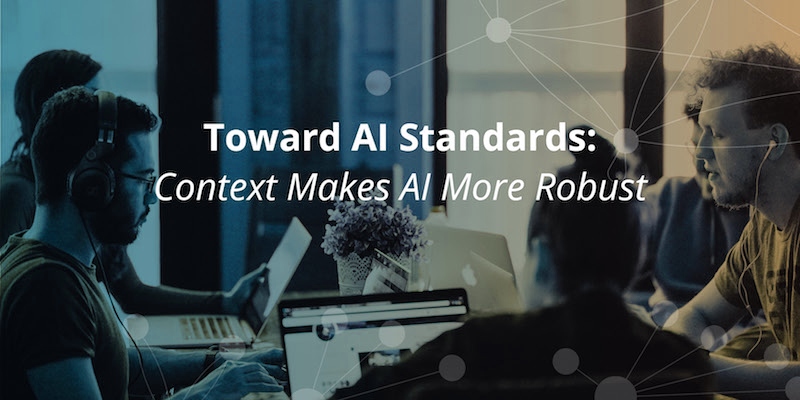Toward AI Standards: Context Makes AI More Robust

Graph Analytics & AI Program Director
4 min read

Last week, in part two of our series Toward AI Solutions, we explore graph technology as the fabric for AI context:
“More recently, graph technologies have been increasingly integrated with machine learning and artificial intelligence solutions. These applications include using connections to predict with better accuracy, to make decisions with more flexibility, to track verifiable data lineage, and to understand decision pathways for improved explainability.”
This segues nicely into this week’s series topic, which centers on how and why context makes AI more robust, improving predictions and flexibility.
Better Predictions
One of the greatest challenges in training artificial intelligence models is gathering enough relevant data. And yet current methods don’t incorporate existing relationships within data, essentially throwing out predictive information. Using context adds relevant information and results in better predictions – all with only the data we already have.
According to Stratistics MRC, the global fraud detection and prevention market was valued at $17.5 billion in 2017 and is expected to grow to $120 billion by 2026, and there’s been over 48,000 U.S. patents for graph fraud/anomaly detection issued in the last 10 years.
Many financial services companies are looking for graphs to reveal predictive patterns, find unusual behavior, and score influential entities. All of this contextual information is then loaded into their machine learning models.
Even beyond the obvious fit in financial services, people are using graph algorithms in various industries to create (engineer) more predictive “features” that train AI models for higher accuracy and precision.
For example, the Association for the Advancement of Artificial Intelligence used graph algorithms to detect clusters of interactions between doctors and pharmacies to improve opioid fraud predictions as described in “Graph Analysis for Detecting Fraud, Waste, and Abuse in Health-Care Data.”
Today’s data is highly connected and has uneven concentrations, which basic statistics and averages completely miss. Graph algorithms are specifically developed to leverage the topology of data through connections: find communities, uncover influential components and infer patterns and structure.
Incorporating the predictive elements of context and relationships into machine learning greatly increases model accuracy and precision – with the data we already have.
Situational Flexibility
Situational awareness and appropriateness is another concern for AI where context-based learning and action are critical.
For example, consider how we want an age-appropriate chatbot sensing and responding differently in an interaction with a 7-year-old versus a 30-year-old. In fact, an investigation highlighted an egregious example: a mental health chatbot created for use by children was unable to understand a child explicitly reporting underage sexual abuse as reported in the BBC news, “Child advice chatbots fail to spot sexual abuse.”
AI-based systems need to be flexible, which includes designing AI in a way that views user interaction as critical to the design and implementation of autonomous decision-making systems. This user-centric thinking might have helped prevent the recent loss of two Boeing 737 MAX aircraft, which investigations revealed were partly due to the failure to incorporate pilot behavior into automated systems.
Contextual information also helps an AI solution flex within new situations that it is untrained for, reducing failures and equipping it with new data or unexpected scenarios.
For example, a semi-autonomous car might be programmed to slow down in rainy weather, but we would also want it to expand its AI application to incorporate contextual information such as falling temperature and an approaching bridge. Or especially difficult, situally apply learning to break for objects in the road such as a dog but not slam on the breaks for a paper bag or flock of birds.
Finally, when AI solutions are based on contextually aware and dynamic backends they are more broadly applicable. In turn, they will spur new innovations and broaden competition. We know that graph technologies are inherently cross-sector, with Neo4j’s graph platform used globally by:
- 20 of the top 25 financial services firms
- 7 of the top 10 software firms
- 3 of the top 5 logistics firms
- 7 of the top 10 retailers
- 3 of the top 5 airlines
- 4 of the top 5 telecommunications firms
- And 3 of the top 5 hospitality companies
Conclusion
Robustness is an interesting concept. We want our AI to be robust in ways that mean they can handle hard problems and make the best possible decisions. We also want our AI to be robust in ways that mean they can flex and handle new and unexpected situations.
Incorporating adjacent information using graphs provides the context AI systems need to make more accurate predictions while also broadening its applicability and resilience.
Stay tuned for next week’s blog in this series, the final blog, where we discover even more benefits adding context to AI.
Catch up with the rest of the Toward AI Standards series:
- Graph Technology for Responsible AI
- Graph Technology as a Fabric for Context
- Toward AI Standards: Context Makes AI More Reliable and Trustworthy
Read the white paper, Artificial Intelligence & Graph Technology: Enhancing AI with Context & Connections









